SOC302 - Global Politics of Food and Eating: A Detailed Analysis
VerifiedAdded on 2023/03/30
|9
|1952
|65
Essay
AI Summary
This essay delves into the sociological aspects of food and globalization, examining how food and diet are significant in national identity and nationalism. It discusses the 'top-down' attribute of nationalism, the concept of 'floating food' in diasporic contexts, and the importance of commensality in human society. The essay also explores the consumer republic and the politics of mass consumption in postwar America, as well as the omnivore's dilemma and the uncertainties surrounding food consumption. Furthermore, it analyzes gastronationalism, linking food production and consumption to national identity and cultural patrimony, highlighting its role in contemporary food culture. The essay concludes that gastronationalism is a critical concept for sociologists, reflecting social situations where market-based recognitions align with national boundaries.
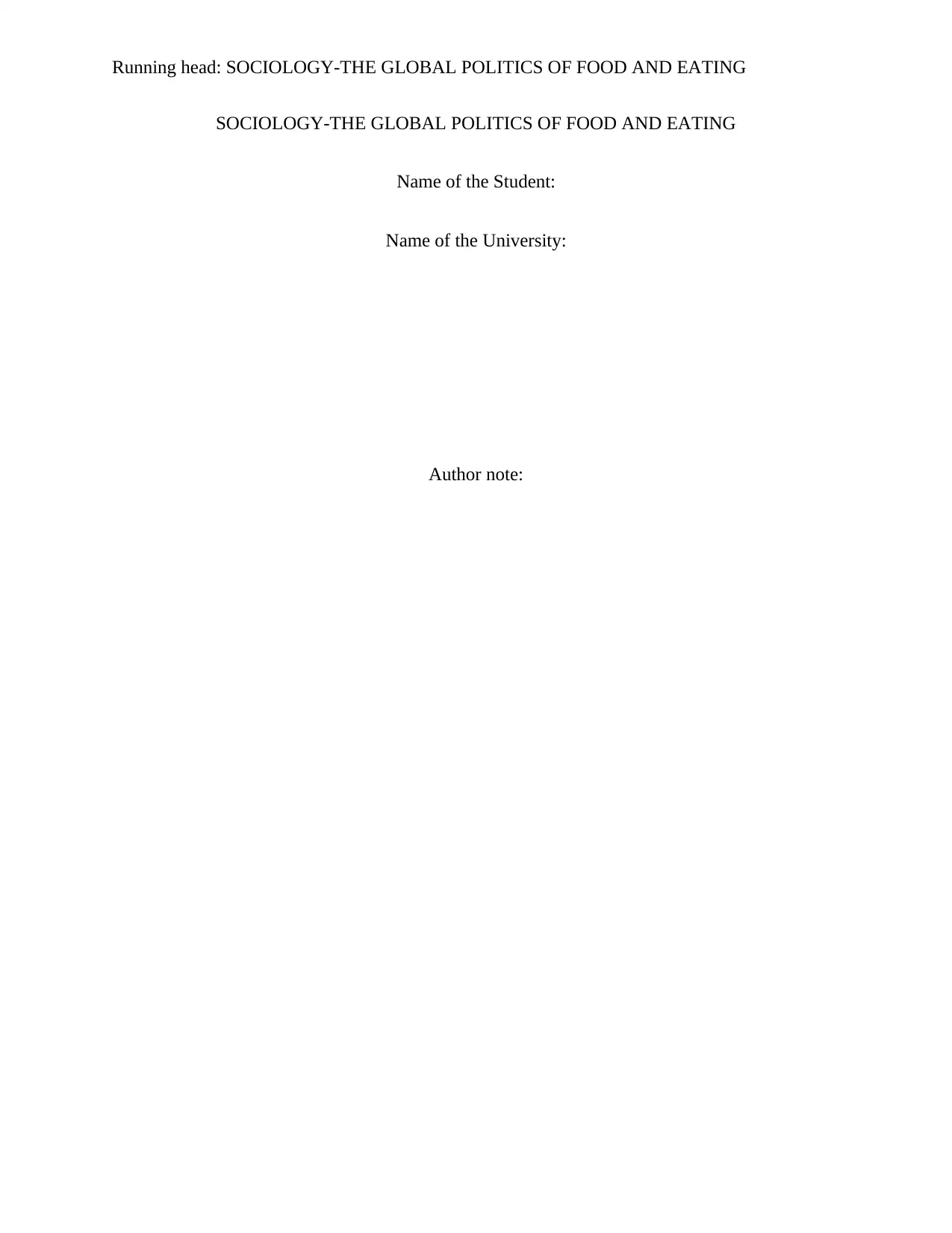
Running head: SOCIOLOGY-THE GLOBAL POLITICS OF FOOD AND EATING
SOCIOLOGY-THE GLOBAL POLITICS OF FOOD AND EATING
Name of the Student:
Name of the University:
Author note:
SOCIOLOGY-THE GLOBAL POLITICS OF FOOD AND EATING
Name of the Student:
Name of the University:
Author note:
Paraphrase This Document
Need a fresh take? Get an instant paraphrase of this document with our AI Paraphraser
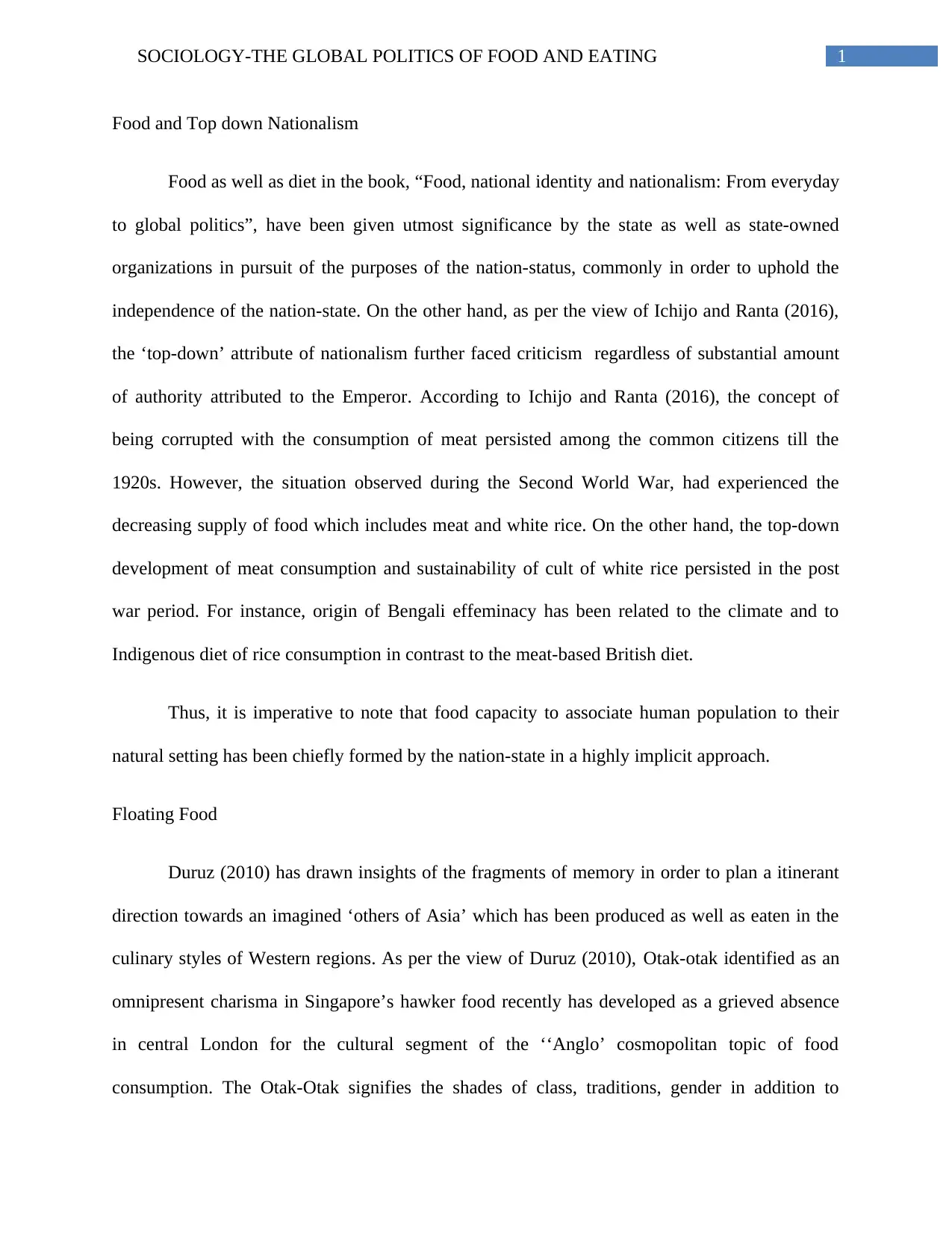
1SOCIOLOGY-THE GLOBAL POLITICS OF FOOD AND EATING
Food and Top down Nationalism
Food as well as diet in the book, “Food, national identity and nationalism: From everyday
to global politics”, have been given utmost significance by the state as well as state-owned
organizations in pursuit of the purposes of the nation-status, commonly in order to uphold the
independence of the nation-state. On the other hand, as per the view of Ichijo and Ranta (2016),
the ‘top-down’ attribute of nationalism further faced criticism regardless of substantial amount
of authority attributed to the Emperor. According to Ichijo and Ranta (2016), the concept of
being corrupted with the consumption of meat persisted among the common citizens till the
1920s. However, the situation observed during the Second World War, had experienced the
decreasing supply of food which includes meat and white rice. On the other hand, the top-down
development of meat consumption and sustainability of cult of white rice persisted in the post
war period. For instance, origin of Bengali effeminacy has been related to the climate and to
Indigenous diet of rice consumption in contrast to the meat-based British diet.
Thus, it is imperative to note that food capacity to associate human population to their
natural setting has been chiefly formed by the nation-state in a highly implicit approach.
Floating Food
Duruz (2010) has drawn insights of the fragments of memory in order to plan a itinerant
direction towards an imagined ‘others of Asia’ which has been produced as well as eaten in the
culinary styles of Western regions. As per the view of Duruz (2010), Otak-otak identified as an
omnipresent charisma in Singapore’s hawker food recently has developed as a grieved absence
in central London for the cultural segment of the ‘‘Anglo’ cosmopolitan topic of food
consumption. The Otak-Otak signifies the shades of class, traditions, gender in addition to
Food and Top down Nationalism
Food as well as diet in the book, “Food, national identity and nationalism: From everyday
to global politics”, have been given utmost significance by the state as well as state-owned
organizations in pursuit of the purposes of the nation-status, commonly in order to uphold the
independence of the nation-state. On the other hand, as per the view of Ichijo and Ranta (2016),
the ‘top-down’ attribute of nationalism further faced criticism regardless of substantial amount
of authority attributed to the Emperor. According to Ichijo and Ranta (2016), the concept of
being corrupted with the consumption of meat persisted among the common citizens till the
1920s. However, the situation observed during the Second World War, had experienced the
decreasing supply of food which includes meat and white rice. On the other hand, the top-down
development of meat consumption and sustainability of cult of white rice persisted in the post
war period. For instance, origin of Bengali effeminacy has been related to the climate and to
Indigenous diet of rice consumption in contrast to the meat-based British diet.
Thus, it is imperative to note that food capacity to associate human population to their
natural setting has been chiefly formed by the nation-state in a highly implicit approach.
Floating Food
Duruz (2010) has drawn insights of the fragments of memory in order to plan a itinerant
direction towards an imagined ‘others of Asia’ which has been produced as well as eaten in the
culinary styles of Western regions. As per the view of Duruz (2010), Otak-otak identified as an
omnipresent charisma in Singapore’s hawker food recently has developed as a grieved absence
in central London for the cultural segment of the ‘‘Anglo’ cosmopolitan topic of food
consumption. The Otak-Otak signifies the shades of class, traditions, gender in addition to

2SOCIOLOGY-THE GLOBAL POLITICS OF FOOD AND EATING
sensory picture that reflected an unforgettable moment for distinctiveness regarding ‘floating’’
and trance of entanglement and restrictions. Duruz (2010) has cited an example of a British Born
citizen, James who has spent his initial days in Hong Kong and experienced the issue of
fragments of memory regarding food where his memories, have been shaped by a double
diaspora of memories that British child growing up in Hong Kong, jointly with the yearning of a
repatriated British filled with nostalgia intended for the tastes as well as smells of his Asian
cultural patterns.
Thus, it is vital to note that the storyline richness of daily exchanges between strangers
and familiars in the culinary process have been highly productive with ways of accepting the
intricacies of diasporic place-making.
Commensality
The article has mentioned that one of the mainly prominent understandings of human
society is related to commensality where individuals have a propensity to eat collectively as well
as in groupings. Thus, to the opinion of Fischler (2011), in contemporary times, the issues
highlighted during the early 1990s have attained in utmost intensity and in developed as well as
in developing nations. The Fischler (2011) has drawn insights from former studies which
concluded that commensality typically unites the public as well as private arena. If previous
studies dependent on the ideas of Simmel shows relevance then commensality tends to collapse
both private and public, then food cannot be regarded as another type of consumption which
cannot be privatized rather seen as a regular merchandise or commodity. At this juncture,
Fischler (2011) has noted that the dialectic between public as well as private and flanked by
personal and institutional shows highly reliable and thus be studied across history as well as
sensory picture that reflected an unforgettable moment for distinctiveness regarding ‘floating’’
and trance of entanglement and restrictions. Duruz (2010) has cited an example of a British Born
citizen, James who has spent his initial days in Hong Kong and experienced the issue of
fragments of memory regarding food where his memories, have been shaped by a double
diaspora of memories that British child growing up in Hong Kong, jointly with the yearning of a
repatriated British filled with nostalgia intended for the tastes as well as smells of his Asian
cultural patterns.
Thus, it is vital to note that the storyline richness of daily exchanges between strangers
and familiars in the culinary process have been highly productive with ways of accepting the
intricacies of diasporic place-making.
Commensality
The article has mentioned that one of the mainly prominent understandings of human
society is related to commensality where individuals have a propensity to eat collectively as well
as in groupings. Thus, to the opinion of Fischler (2011), in contemporary times, the issues
highlighted during the early 1990s have attained in utmost intensity and in developed as well as
in developing nations. The Fischler (2011) has drawn insights from former studies which
concluded that commensality typically unites the public as well as private arena. If previous
studies dependent on the ideas of Simmel shows relevance then commensality tends to collapse
both private and public, then food cannot be regarded as another type of consumption which
cannot be privatized rather seen as a regular merchandise or commodity. At this juncture,
Fischler (2011) has noted that the dialectic between public as well as private and flanked by
personal and institutional shows highly reliable and thus be studied across history as well as
⊘ This is a preview!⊘
Do you want full access?
Subscribe today to unlock all pages.

Trusted by 1+ million students worldwide
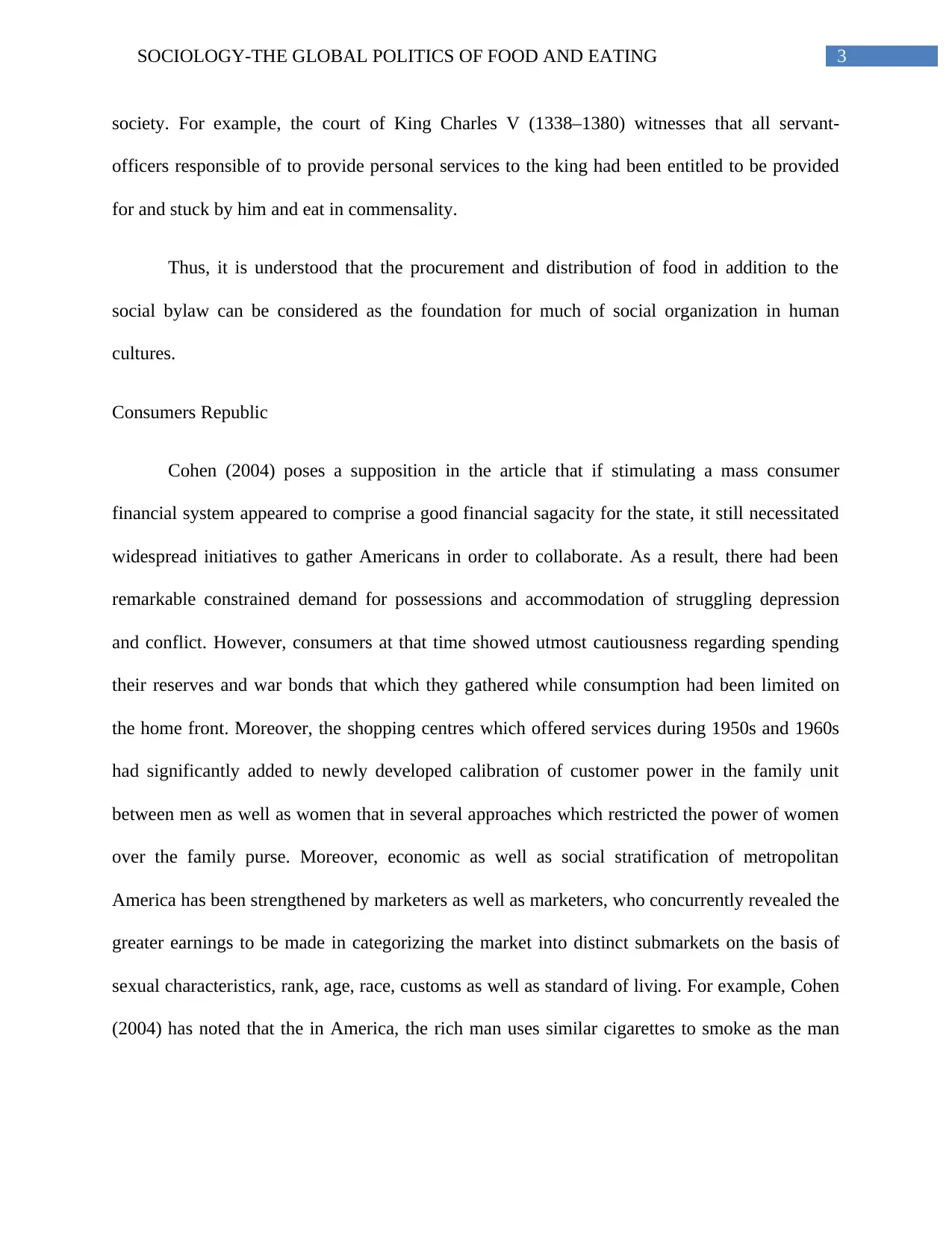
3SOCIOLOGY-THE GLOBAL POLITICS OF FOOD AND EATING
society. For example, the court of King Charles V (1338–1380) witnesses that all servant-
officers responsible of to provide personal services to the king had been entitled to be provided
for and stuck by him and eat in commensality.
Thus, it is understood that the procurement and distribution of food in addition to the
social bylaw can be considered as the foundation for much of social organization in human
cultures.
Consumers Republic
Cohen (2004) poses a supposition in the article that if stimulating a mass consumer
financial system appeared to comprise a good financial sagacity for the state, it still necessitated
widespread initiatives to gather Americans in order to collaborate. As a result, there had been
remarkable constrained demand for possessions and accommodation of struggling depression
and conflict. However, consumers at that time showed utmost cautiousness regarding spending
their reserves and war bonds that which they gathered while consumption had been limited on
the home front. Moreover, the shopping centres which offered services during 1950s and 1960s
had significantly added to newly developed calibration of customer power in the family unit
between men as well as women that in several approaches which restricted the power of women
over the family purse. Moreover, economic as well as social stratification of metropolitan
America has been strengthened by marketers as well as marketers, who concurrently revealed the
greater earnings to be made in categorizing the market into distinct submarkets on the basis of
sexual characteristics, rank, age, race, customs as well as standard of living. For example, Cohen
(2004) has noted that the in America, the rich man uses similar cigarettes to smoke as the man
society. For example, the court of King Charles V (1338–1380) witnesses that all servant-
officers responsible of to provide personal services to the king had been entitled to be provided
for and stuck by him and eat in commensality.
Thus, it is understood that the procurement and distribution of food in addition to the
social bylaw can be considered as the foundation for much of social organization in human
cultures.
Consumers Republic
Cohen (2004) poses a supposition in the article that if stimulating a mass consumer
financial system appeared to comprise a good financial sagacity for the state, it still necessitated
widespread initiatives to gather Americans in order to collaborate. As a result, there had been
remarkable constrained demand for possessions and accommodation of struggling depression
and conflict. However, consumers at that time showed utmost cautiousness regarding spending
their reserves and war bonds that which they gathered while consumption had been limited on
the home front. Moreover, the shopping centres which offered services during 1950s and 1960s
had significantly added to newly developed calibration of customer power in the family unit
between men as well as women that in several approaches which restricted the power of women
over the family purse. Moreover, economic as well as social stratification of metropolitan
America has been strengthened by marketers as well as marketers, who concurrently revealed the
greater earnings to be made in categorizing the market into distinct submarkets on the basis of
sexual characteristics, rank, age, race, customs as well as standard of living. For example, Cohen
(2004) has noted that the in America, the rich man uses similar cigarettes to smoke as the man
Paraphrase This Document
Need a fresh take? Get an instant paraphrase of this document with our AI Paraphraser
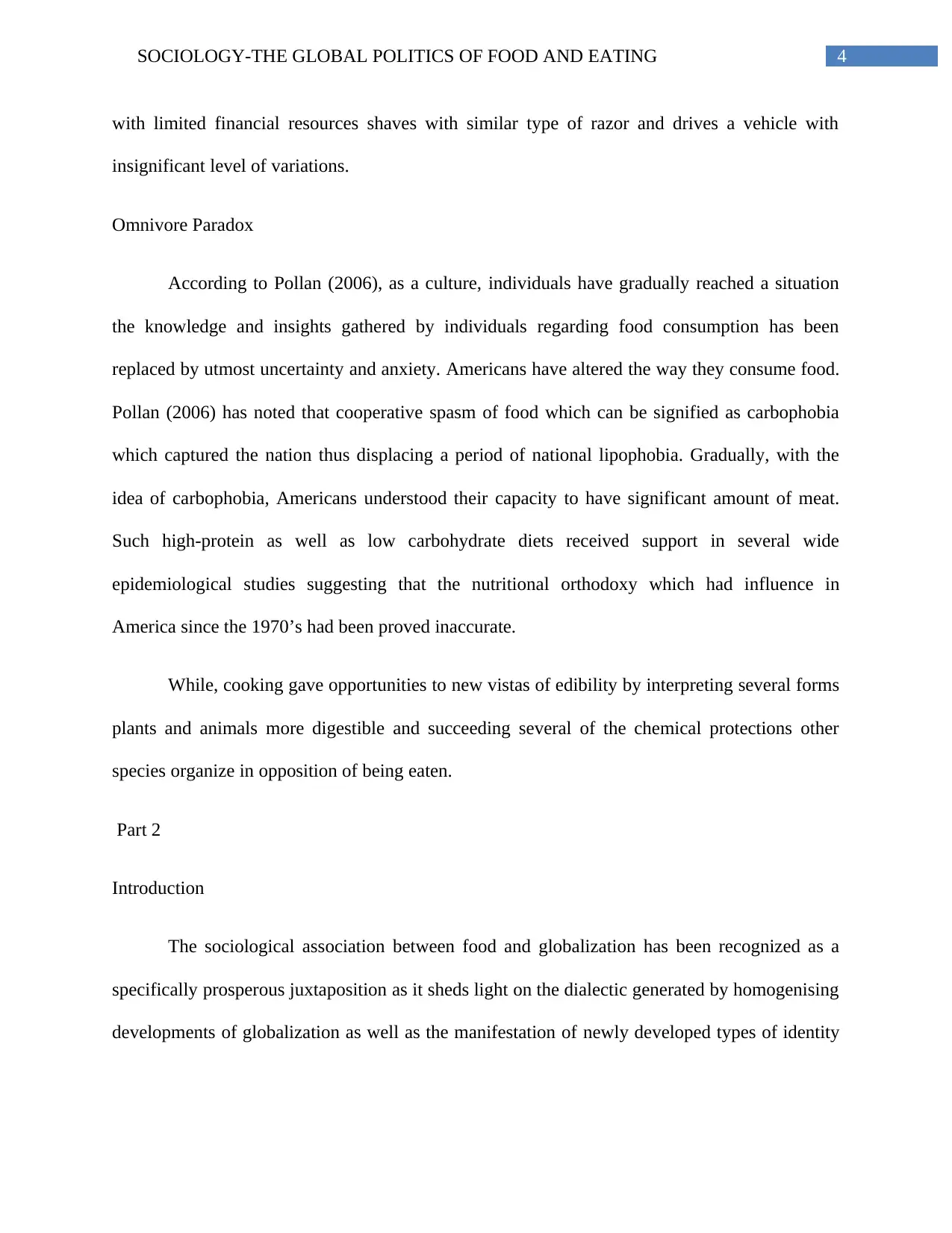
4SOCIOLOGY-THE GLOBAL POLITICS OF FOOD AND EATING
with limited financial resources shaves with similar type of razor and drives a vehicle with
insignificant level of variations.
Omnivore Paradox
According to Pollan (2006), as a culture, individuals have gradually reached a situation
the knowledge and insights gathered by individuals regarding food consumption has been
replaced by utmost uncertainty and anxiety. Americans have altered the way they consume food.
Pollan (2006) has noted that cooperative spasm of food which can be signified as carbophobia
which captured the nation thus displacing a period of national lipophobia. Gradually, with the
idea of carbophobia, Americans understood their capacity to have significant amount of meat.
Such high-protein as well as low carbohydrate diets received support in several wide
epidemiological studies suggesting that the nutritional orthodoxy which had influence in
America since the 1970’s had been proved inaccurate.
While, cooking gave opportunities to new vistas of edibility by interpreting several forms
plants and animals more digestible and succeeding several of the chemical protections other
species organize in opposition of being eaten.
Part 2
Introduction
The sociological association between food and globalization has been recognized as a
specifically prosperous juxtaposition as it sheds light on the dialectic generated by homogenising
developments of globalization as well as the manifestation of newly developed types of identity
with limited financial resources shaves with similar type of razor and drives a vehicle with
insignificant level of variations.
Omnivore Paradox
According to Pollan (2006), as a culture, individuals have gradually reached a situation
the knowledge and insights gathered by individuals regarding food consumption has been
replaced by utmost uncertainty and anxiety. Americans have altered the way they consume food.
Pollan (2006) has noted that cooperative spasm of food which can be signified as carbophobia
which captured the nation thus displacing a period of national lipophobia. Gradually, with the
idea of carbophobia, Americans understood their capacity to have significant amount of meat.
Such high-protein as well as low carbohydrate diets received support in several wide
epidemiological studies suggesting that the nutritional orthodoxy which had influence in
America since the 1970’s had been proved inaccurate.
While, cooking gave opportunities to new vistas of edibility by interpreting several forms
plants and animals more digestible and succeeding several of the chemical protections other
species organize in opposition of being eaten.
Part 2
Introduction
The sociological association between food and globalization has been recognized as a
specifically prosperous juxtaposition as it sheds light on the dialectic generated by homogenising
developments of globalization as well as the manifestation of newly developed types of identity
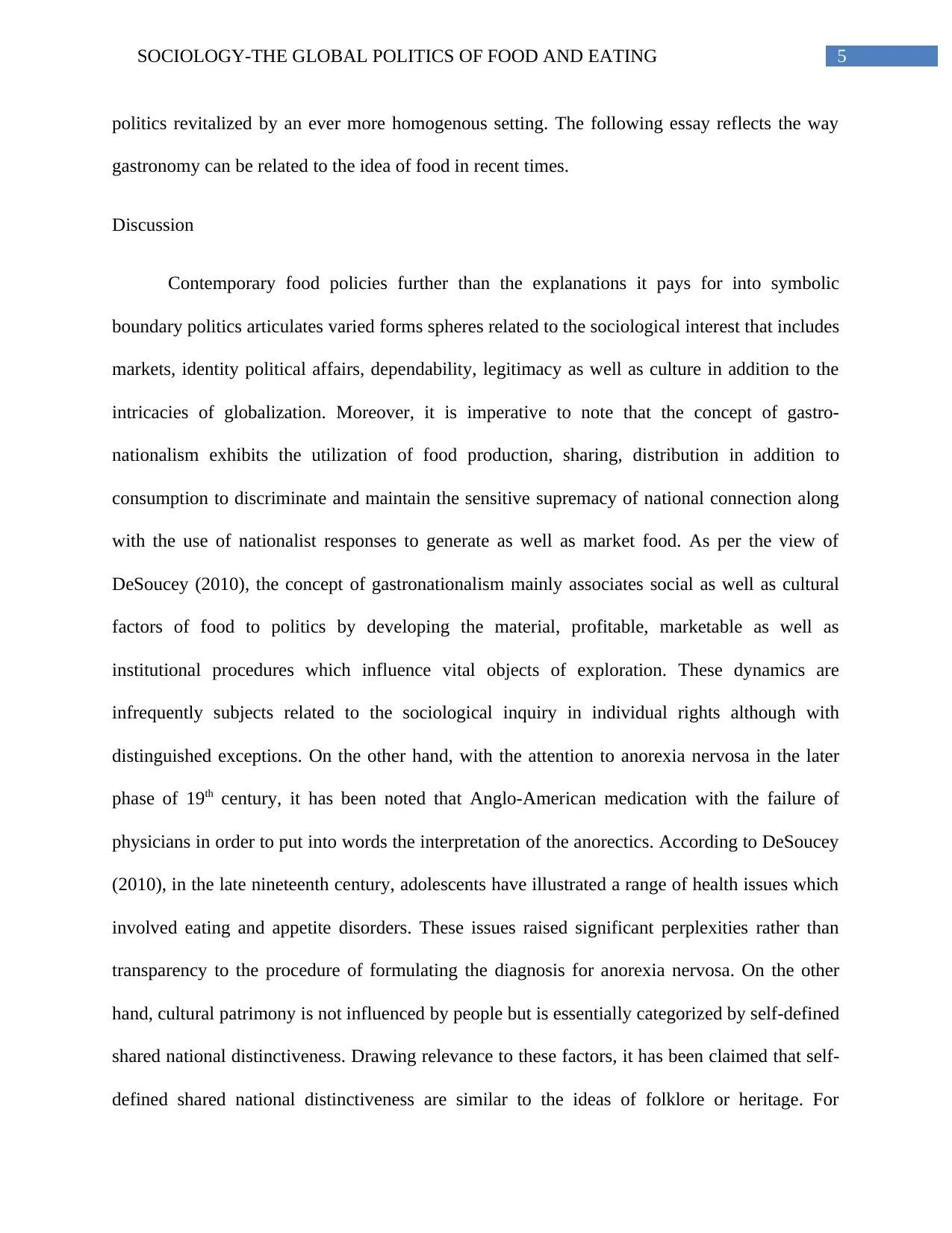
5SOCIOLOGY-THE GLOBAL POLITICS OF FOOD AND EATING
politics revitalized by an ever more homogenous setting. The following essay reflects the way
gastronomy can be related to the idea of food in recent times.
Discussion
Contemporary food policies further than the explanations it pays for into symbolic
boundary politics articulates varied forms spheres related to the sociological interest that includes
markets, identity political affairs, dependability, legitimacy as well as culture in addition to the
intricacies of globalization. Moreover, it is imperative to note that the concept of gastro-
nationalism exhibits the utilization of food production, sharing, distribution in addition to
consumption to discriminate and maintain the sensitive supremacy of national connection along
with the use of nationalist responses to generate as well as market food. As per the view of
DeSoucey (2010), the concept of gastronationalism mainly associates social as well as cultural
factors of food to politics by developing the material, profitable, marketable as well as
institutional procedures which influence vital objects of exploration. These dynamics are
infrequently subjects related to the sociological inquiry in individual rights although with
distinguished exceptions. On the other hand, with the attention to anorexia nervosa in the later
phase of 19th century, it has been noted that Anglo-American medication with the failure of
physicians in order to put into words the interpretation of the anorectics. According to DeSoucey
(2010), in the late nineteenth century, adolescents have illustrated a range of health issues which
involved eating and appetite disorders. These issues raised significant perplexities rather than
transparency to the procedure of formulating the diagnosis for anorexia nervosa. On the other
hand, cultural patrimony is not influenced by people but is essentially categorized by self-defined
shared national distinctiveness. Drawing relevance to these factors, it has been claimed that self-
defined shared national distinctiveness are similar to the ideas of folklore or heritage. For
politics revitalized by an ever more homogenous setting. The following essay reflects the way
gastronomy can be related to the idea of food in recent times.
Discussion
Contemporary food policies further than the explanations it pays for into symbolic
boundary politics articulates varied forms spheres related to the sociological interest that includes
markets, identity political affairs, dependability, legitimacy as well as culture in addition to the
intricacies of globalization. Moreover, it is imperative to note that the concept of gastro-
nationalism exhibits the utilization of food production, sharing, distribution in addition to
consumption to discriminate and maintain the sensitive supremacy of national connection along
with the use of nationalist responses to generate as well as market food. As per the view of
DeSoucey (2010), the concept of gastronationalism mainly associates social as well as cultural
factors of food to politics by developing the material, profitable, marketable as well as
institutional procedures which influence vital objects of exploration. These dynamics are
infrequently subjects related to the sociological inquiry in individual rights although with
distinguished exceptions. On the other hand, with the attention to anorexia nervosa in the later
phase of 19th century, it has been noted that Anglo-American medication with the failure of
physicians in order to put into words the interpretation of the anorectics. According to DeSoucey
(2010), in the late nineteenth century, adolescents have illustrated a range of health issues which
involved eating and appetite disorders. These issues raised significant perplexities rather than
transparency to the procedure of formulating the diagnosis for anorexia nervosa. On the other
hand, cultural patrimony is not influenced by people but is essentially categorized by self-defined
shared national distinctiveness. Drawing relevance to these factors, it has been claimed that self-
defined shared national distinctiveness are similar to the ideas of folklore or heritage. For
⊘ This is a preview!⊘
Do you want full access?
Subscribe today to unlock all pages.

Trusted by 1+ million students worldwide

6SOCIOLOGY-THE GLOBAL POLITICS OF FOOD AND EATING
instance, despite the fact that old pictures can be believed cultural possessions, Leonardo da
Vinci’s Last Supper and Botticelli’s Birth of Venus are sorted as Italian educational patrimony
(Counihan and Van Esterik 2012). At this juncture, DeSoucey (2010) has noted that
Gastronationalism shows utmost exclusiveness in this regard as it tends to forbid other
individuals from making related food assertions materially or through symbolic representation.
Gastronationalism further has been interesting to direct level of shared characteristics that
distinguishes boundaries between insiders as well as outsiders. Meanwhile, associating
environment as well as the objective setting with genuine products represents consideration to
the materiality of gastronationalism. However, on the contrary to environmental as well as
ecological discussions developed as nineteenth-century idealism that current environment as
either a utopian ecstasy or an intimidating backwoods external to the bounds of human society.
Furthermore, DeSoucey (2010) has noted that in anticipation of the beginning of industrialized
foie gras production, it has been mainly considered as the chief role of elder female family
members in to indulge in poultry activities in addition to other small animals for domestic costs.
Gastronationalism thus is identified as a critical claims making mechanism meant for
sociologists in order to take into consideration the concept of gastronomy with contemporary
food culture. DeSoucey (2010) has claimed that as few scholars have the implication to
understand such regulations as simply defensive towards material welfares, other studies have
claimed that gastronationalism’s contentiousness tends to create a resource of cultural as well as
national demarcation. Furthermore, even though concept of gastronomy remains as a politically
embedded and influenced by markets, gastronationalism explains prototypes of and further assert
for exceptionalism on the basis of ideas as well as perceptions reacted to cultural practices as
well as patrimony (Counihan and Van Esterik 2012). Thus, gastronomy strategically aligns to the
instance, despite the fact that old pictures can be believed cultural possessions, Leonardo da
Vinci’s Last Supper and Botticelli’s Birth of Venus are sorted as Italian educational patrimony
(Counihan and Van Esterik 2012). At this juncture, DeSoucey (2010) has noted that
Gastronationalism shows utmost exclusiveness in this regard as it tends to forbid other
individuals from making related food assertions materially or through symbolic representation.
Gastronationalism further has been interesting to direct level of shared characteristics that
distinguishes boundaries between insiders as well as outsiders. Meanwhile, associating
environment as well as the objective setting with genuine products represents consideration to
the materiality of gastronationalism. However, on the contrary to environmental as well as
ecological discussions developed as nineteenth-century idealism that current environment as
either a utopian ecstasy or an intimidating backwoods external to the bounds of human society.
Furthermore, DeSoucey (2010) has noted that in anticipation of the beginning of industrialized
foie gras production, it has been mainly considered as the chief role of elder female family
members in to indulge in poultry activities in addition to other small animals for domestic costs.
Gastronationalism thus is identified as a critical claims making mechanism meant for
sociologists in order to take into consideration the concept of gastronomy with contemporary
food culture. DeSoucey (2010) has claimed that as few scholars have the implication to
understand such regulations as simply defensive towards material welfares, other studies have
claimed that gastronationalism’s contentiousness tends to create a resource of cultural as well as
national demarcation. Furthermore, even though concept of gastronomy remains as a politically
embedded and influenced by markets, gastronationalism explains prototypes of and further assert
for exceptionalism on the basis of ideas as well as perceptions reacted to cultural practices as
well as patrimony (Counihan and Van Esterik 2012). Thus, gastronomy strategically aligns to the
Paraphrase This Document
Need a fresh take? Get an instant paraphrase of this document with our AI Paraphraser
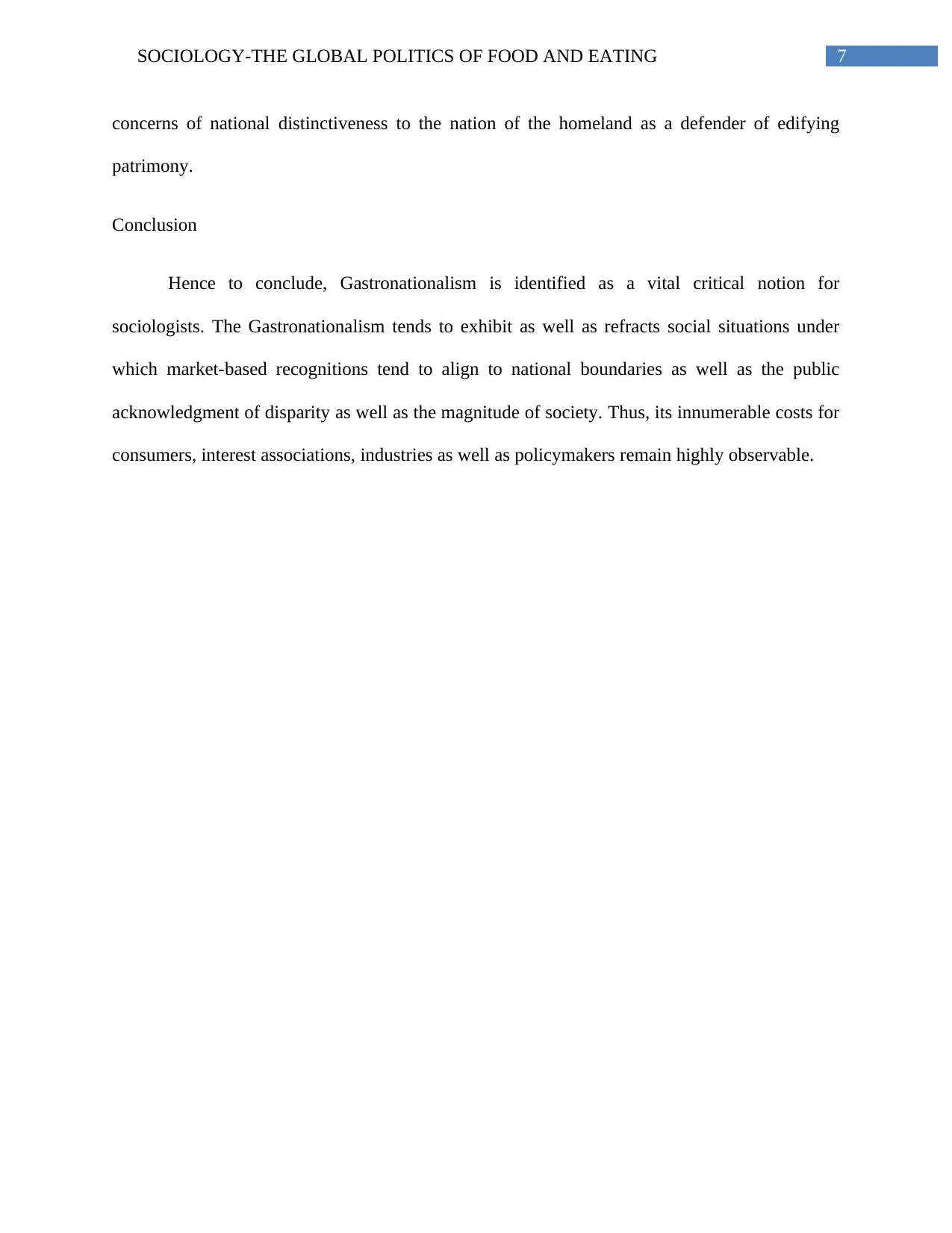
7SOCIOLOGY-THE GLOBAL POLITICS OF FOOD AND EATING
concerns of national distinctiveness to the nation of the homeland as a defender of edifying
patrimony.
Conclusion
Hence to conclude, Gastronationalism is identified as a vital critical notion for
sociologists. The Gastronationalism tends to exhibit as well as refracts social situations under
which market-based recognitions tend to align to national boundaries as well as the public
acknowledgment of disparity as well as the magnitude of society. Thus, its innumerable costs for
consumers, interest associations, industries as well as policymakers remain highly observable.
concerns of national distinctiveness to the nation of the homeland as a defender of edifying
patrimony.
Conclusion
Hence to conclude, Gastronationalism is identified as a vital critical notion for
sociologists. The Gastronationalism tends to exhibit as well as refracts social situations under
which market-based recognitions tend to align to national boundaries as well as the public
acknowledgment of disparity as well as the magnitude of society. Thus, its innumerable costs for
consumers, interest associations, industries as well as policymakers remain highly observable.
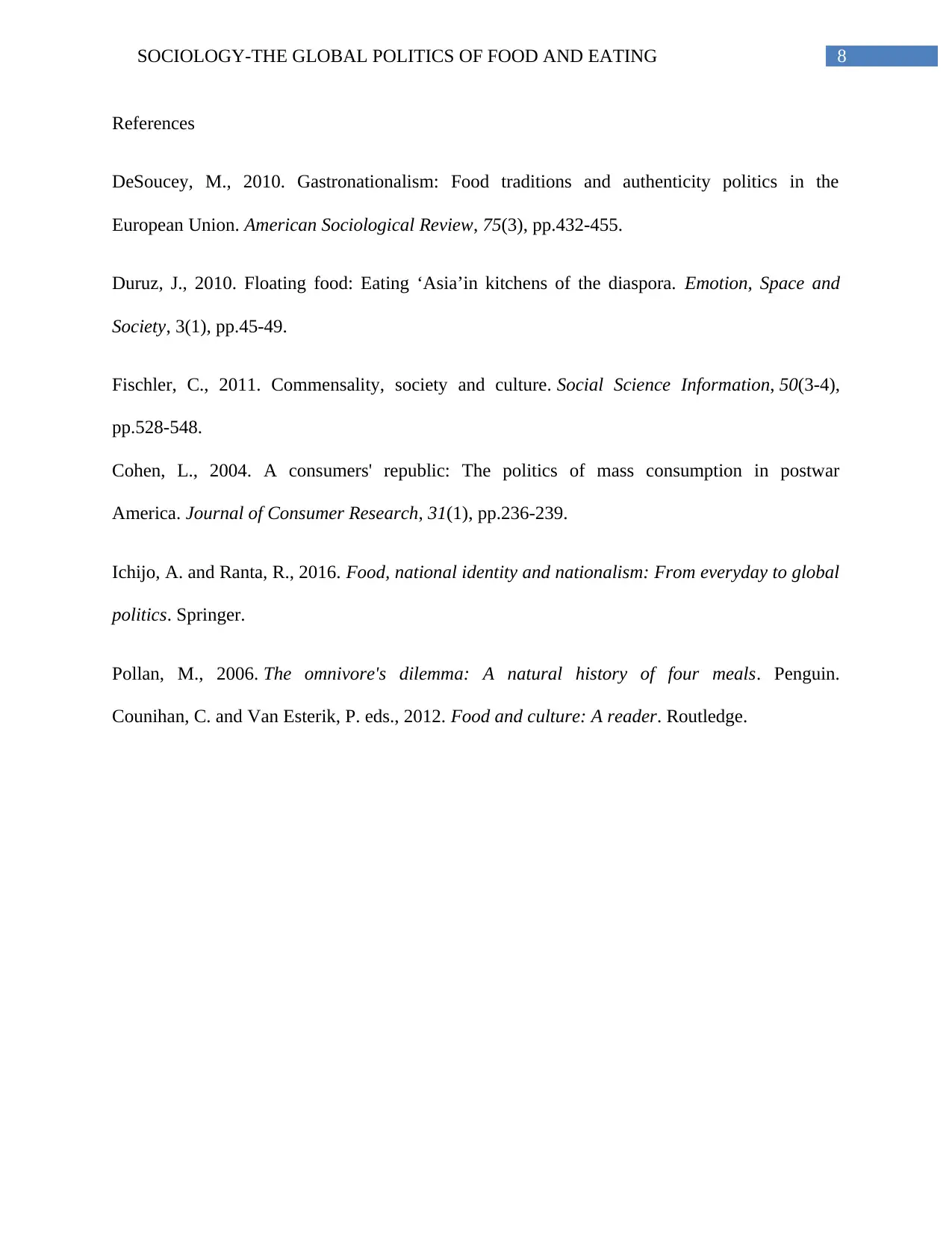
8SOCIOLOGY-THE GLOBAL POLITICS OF FOOD AND EATING
References
DeSoucey, M., 2010. Gastronationalism: Food traditions and authenticity politics in the
European Union. American Sociological Review, 75(3), pp.432-455.
Duruz, J., 2010. Floating food: Eating ‘Asia’in kitchens of the diaspora. Emotion, Space and
Society, 3(1), pp.45-49.
Fischler, C., 2011. Commensality, society and culture. Social Science Information, 50(3-4),
pp.528-548.
Cohen, L., 2004. A consumers' republic: The politics of mass consumption in postwar
America. Journal of Consumer Research, 31(1), pp.236-239.
Ichijo, A. and Ranta, R., 2016. Food, national identity and nationalism: From everyday to global
politics. Springer.
Pollan, M., 2006. The omnivore's dilemma: A natural history of four meals. Penguin.
Counihan, C. and Van Esterik, P. eds., 2012. Food and culture: A reader. Routledge.
References
DeSoucey, M., 2010. Gastronationalism: Food traditions and authenticity politics in the
European Union. American Sociological Review, 75(3), pp.432-455.
Duruz, J., 2010. Floating food: Eating ‘Asia’in kitchens of the diaspora. Emotion, Space and
Society, 3(1), pp.45-49.
Fischler, C., 2011. Commensality, society and culture. Social Science Information, 50(3-4),
pp.528-548.
Cohen, L., 2004. A consumers' republic: The politics of mass consumption in postwar
America. Journal of Consumer Research, 31(1), pp.236-239.
Ichijo, A. and Ranta, R., 2016. Food, national identity and nationalism: From everyday to global
politics. Springer.
Pollan, M., 2006. The omnivore's dilemma: A natural history of four meals. Penguin.
Counihan, C. and Van Esterik, P. eds., 2012. Food and culture: A reader. Routledge.
⊘ This is a preview!⊘
Do you want full access?
Subscribe today to unlock all pages.

Trusted by 1+ million students worldwide
1 out of 9
Your All-in-One AI-Powered Toolkit for Academic Success.
+13062052269
info@desklib.com
Available 24*7 on WhatsApp / Email
![[object Object]](/_next/static/media/star-bottom.7253800d.svg)
Unlock your academic potential
Copyright © 2020–2025 A2Z Services. All Rights Reserved. Developed and managed by ZUCOL.